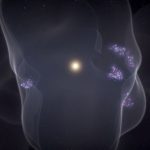Key Takeaways:
- NASA’s Chandra X-ray Observatory captured a black hole ejecting material at near-light speeds from a binary system called MAXI J1820+070, revealing an extraordinary cosmic phenomenon.
- The system, 10,000 light-years from Earth, involves a stellar-mass black hole roughly eight times the mass of the sun and a companion star, generating jets of gas due to material pulled into an accretion disk.
- In an astounding display, around 400 million billion pounds of material were expelled in jets moving at speeds appearing faster than light due to a visual illusion called “superluminal motion.”
- The observations shed light on how these jets interact with their surroundings, revealing insights into the energy release and deceleration mechanisms as particles interact with interstellar material.
- Mathilde Espinasse led the research published in Astrophysical Journal Letters, offering valuable information on black hole activities and the behavior of emitted jets.
In a spectacular cosmic display, NASA’s Chandra X-ray Observatory has unveiled an awe-inspiring phenomenon—material hurtling away from a black hole at velocities nearing the speed of light. This stunning event was captured within the binary system MAXI J1820+070, situated a relatively close 10,000 light-years from Earth, allowing for a detailed exploration of this extraordinary occurrence.
At the heart of this system lies a stellar-mass black hole, approximately eight times the mass of our sun, in a gravitational pas de deux with a companion star about half the size of our sun. The interplay between these cosmic bodies results in a captivating celestial ballet.

The gravitational force of the black hole snatches material from the companion star, spiraling it into an accretion disk, forming a luminous sphere of gas emitting intense X-rays. While some gas succumbs back into the voracious black hole, a portion is propelled away in two jets, shooting off in opposite directions.
The outburst witnessed stands as one of the most high-speed eruptions ever seen from stellar-mass black holes in the X-ray spectrum. In July 2018, an astounding 400 million billion pounds of material—equivalent to around 181 million billion kilograms—were expelled in these jets, an amount comparable to the accumulation on the disk surrounding the black hole within mere hours. To put it into perspective, this mass equates to approximately a thousand Halley’s Comets or roughly 500 million times the mass of the Empire State Building.
Captured in four sets of observations by Chandra in 2018 and three times in 2019, these jets seemingly move at incredible speeds, sparking a visual puzzle. The northern jet gives the impression of ejecting material at 60% of the speed of light, while the southern jet appears to surpass physical constraints at 160% of the speed of light.
However, this illusionary effect, known as “superluminal motion,” occurs when an object travels toward an observer near the speed of light, creating the perception of surpassing light speed due to the direction of motion relative to the observer’s line of sight.
NASA clarified that while the southern jet seems to defy the laws of physics, both jets actually propel particles at velocities exceeding 80% of the speed of light. These observations offer a unique vantage point for understanding the mechanisms behind jet formation and their interaction with the surrounding cosmic environment.
Continued observations of similar binary systems containing black holes and companion stars hold the promise of unraveling more mysteries surrounding these energetic cosmic jets.
Expanding on this discovery, a team led by Joe Bright from the University of Oxford delved into radio wavelength observations, corroborating the phenomenon of superluminal motion based solely on radio data.
Chandra’s contribution to this research extended the duration of observations, allowing astronomers to track the jets over a longer period and supplying crucial X-ray data that indicated particle deceleration as they distanced themselves from the black hole.
The significant revelation arising from these observations is that the bulk of the energy within the jets doesn’t convert into radiation but is rather released during interactions between jet particles and the surrounding matter.
This interaction likely causes the observed deceleration, akin to shock waves generated when supersonic aircraft create sonic booms. These shock waves, occurring as the jets collide with interstellar material, result in particle energies surpassing those generated by the Large Hadron Collider.
The culmination of this groundbreaking research led by Mathilde Espinasse, affiliated with several prominent Parisian universities, culminated in a paper published in Astrophysical Journal Letters.
The findings pave the way for a deeper comprehension of black hole activities, jet dynamics, and the complex interplay between these cosmic phenomena and their surroundings.


